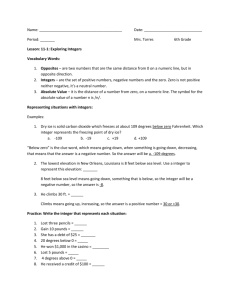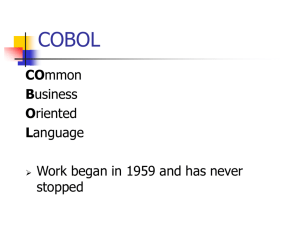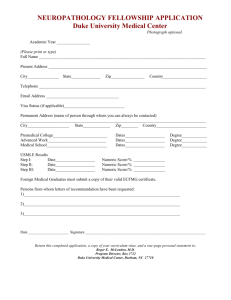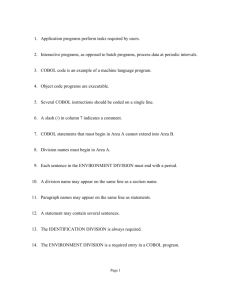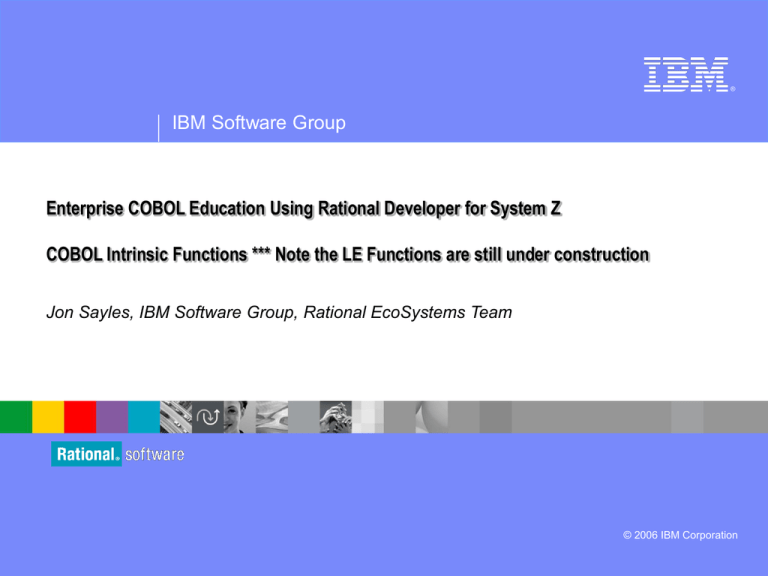
®
IBM Software Group
Enterprise COBOL Education Using Rational Developer for System Z
COBOL Intrinsic Functions *** Note the LE Functions are still under construction
Jon Sayles, IBM Software Group, Rational EcoSystems Team
© 2006 IBM Corporation
IBM Trademarks and Copyrights
© Copyright IBM Corporation 2007,2008, 2009. All rights reserved.
The information contained in these materials is provided for informational purposes
only, and is provided AS IS without warranty of any kind, express or implied. IBM
shall not be responsible for any damages arising out of the use of, or otherwise
related to, these materials. Nothing contained in these materials is intended to, nor
shall have the effect of, creating any warranties or representations from IBM or its
suppliers or licensors, or altering the terms and conditions of the applicable license
agreement governing the use of IBM software. References in these materials to IBM
products, programs, or services do not imply that they will be available in all countries
in which IBM operates.
This information is based on current IBM product plans and strategy, which are
subject to change by IBM without notice. Product release dates and/or capabilities
referenced in these materials may change at any time at IBM’s sole discretion based
on market opportunities or other factors, and are not intended to be a commitment to
future product or feature availability in any way.
IBM, the IBM logo, the on-demand business logo, Rational, the Rational logo, and
other IBM Rational products and services are trademarks or registered trademarks of
the International Business Machines Corporation, in the United States, other
countries or both. Other company, product, or service names may be trademarks or
service marks of others.
2
Course Contributing Authors
Thanks to the following individuals, for assisting with this course:
Tom Ross, IBM
3
Purpose of This Document
Course Name: COBOL Foundation Training - with RDz
Course Description: Learn the COBOL language, RDz and learn z/OS terms, concepts and development skills in
this course.
Pre-requisites: Some experience in a 3rd or 4th Generation Language is expected. SQL is also recommended.
Course Length: 10 days
Topics (Agenda)
Getting Started - installing and configuring RDz - and the course materials, and using Eclipse to edit COBOL
COBOL General Language Rules
Basic COBOL Statements
Structured Programming Concepts and Coding Patterns
Data - numeric and character - deep/dive
Records and table handling - deep/dive
Input/Output and Sequential File patterns
Debugging Programs - Note: Deep dive on using RDz for common COBOL programming errors (001, 0C4, 0C7, infinite loops, fall-thru, etc.)
COBOL Subprograms and the Linkage Section
Advanced Character Manipulation
COBOL Intrinsic Functions, Date and Time coding patterns, and Language Environment calls
Reports and report writing patterns
OS/390 Concepts and JCL (here's where the Sandbox/mainframe access starts)
Compile/Link & Run Procs on the mainframe
Indexed file Coding Patterns
Sort/Merge and Master File Update Coding Patterns
Accessing DB2 Data and Stored Procedures
COBOL in the Real World:
–
–
–
–
–
–
–
CICS - lecture only
IMS (DL/I and TM) - ditto
Batch processing - ditto
Java calling COBOL
COBOL and XML Statements
SOA and COBOL - creating and calling Web Services
Web 2.0 using Rich UI
4
Course Details
Audience
This course is designed for application developers who have learned or
programmed in a 3rd or 4th generation language – and who need to build leadingedge applications using COBOL and Rational Developer for System z.
Prerequisites
This course assumes that the student has a basic understanding and knowledge
of software computing technologies, and general data processing terms,
concepts and vocabulary.
Knowledge of SQL (Structured Query Language) is assumed for database
access is assumed as well.
Basic PC and mouse-driven development skills, terms and concepts are also
assumed.
Note that we will be covering RDz's mainframe-editor-compliant function key idiom in
this unit
5
Course
RBD/EGL Development
Units:
Function Overview
Alphanumeric Functions
Date Functions
Numeric and Integer Functions
Appendices
6
Intrinsic Functions
Some high-level programming languages have built-in functions that you
can reference in your program as if they were variables that have defined
attributes and a predetermined value.
In COBOL, these functions are called intrinsic functions.
They provide capabilities for manipulating strings, dates and numbers.
Examples:
01
01
01
01
01
01
Tax-S
Pic
Tax-T
Pic
Tax-W
Pic
Tax-B
Pic
Ave-Tax
Pic
Median-Tax
Pic
Compute Ave-Tax
=
Compute Median-Tax =
99v999 value .045.
99v999 value .02.
99v999 value .035.
99v999 value .03.
99v999.
99v999.
Function Mean
(Tax-S Tax-T Tax-W Tax-B)
Function Median (Tax-S Tax-T Tax-W Tax-B)
7
Coding Intrinsic Functions – 1 of 3
You code an intrinsic function in one of two ways:
1. Right-to-left (COBOL COMPUTE style)
Specify the Data Division receiving variable name (must be type-compatible with the Function)
Code the equal sign
Code the reserved word: Function (this is capital-insensitive)
Code the Function name
Specify one or more parameters to the function
–
Separate the parameters by one or more blanks (spaces)
Example:
Compute Ave-Tax = Function Mean (Tax-S Tax-T Tax-W Tax-B)
2. Left-to-right (COBOL MOVE style)
Code the COBOL MOVE keyword
Code the reserved word: Function (this is capital-insensitive)
Code the Function name
Specify one or more parameters to the function
–
Separate the parameters by one or more blanks (spaces)
Specify the receiving variable (must be type-compatible with the Function's return value)
Example:
MOVE Function Length (Output-Record) To Rec-Lth
For Intrinsic functions that return a numeric value you can use either the MOVE or
COMPUTE coding style
For intrinsic functions that return a non-numeric value you MUST use the MOVE coding style
8
Coding Intrinsic Functions – 2 of 3
Define only the non-literal data items that you use as arguments in the Data
Division (Figurative constants are not allowed as arguments).
You can reference one function as the argument of another.
A nested function is evaluated independently of the outer function (except when
the compiler determines whether a mixed function should be evaluated using
fixed-point or floating-point instructions).
You can reference all the elements of a table (or array) as function
arguments by using the ALL subscript.
You can also nest an arithmetic expression as an argument to a numeric
function or an IF statement.
Examples:
Compute x = Function Sum(a b (c / d))
IF Function Sum(PriceTab(ALL)) > 9999 PERFORM Check-Price-In
IF Function Max(StudentGrades(ALL)) = "A" Perform …
You can also use the integer special registers as arguments wherever
integer arguments are allowed.
Many of the capabilities of numeric intrinsic functions are also provided by
Language Environment callable services.
9
Coding Intrinsic Functions – 3 of 3
In the IBM documentation, you will see references to function-identifiers.
A function-identifier is the combination of the COBOL reserved word FUNCTION
followed by a function name (such as Max), followed by any arguments to be used
in the evaluation of the function (such as x, y, z).
A function-identifier represents both the invocation of the function and the data value
returned by the function.
Because it actually represents a data item, you can use a function-identifier in most
places in the PROCEDURE DIVISION where a data item that has the attributes of
the returned value can be used.
The COBOL word Function is a reserved word, but the function-names are not
reserved.
You can use them in other contexts, such as for the name of a data item. For
example, you could use Sqrt to invoke an intrinsic function and to name a data item
in your program:
Working-Storage Section.
01 x Pic 99 value 2.
01 y Pic 99 value 4.
01 z Pic 99 value 0.
01 Sqrt Pic 99 value 0
. . . .
Compute Sqrt = 16 ** .5 Compute z = x + Function Sqrt(y)
10
Functions – Additional Coding Considerations
A function-identifier represents a value that is of one of these COBOL datatypes:
alphanumeric, national, numeric, or integer.
You can include a substring specification (reference modifier) in a function-identifier
for alphanumeric or national functions.
Numeric intrinsic functions are further classified according to the type of numbers
they return.
The functions MAX, MIN, DATEVAL, and UNDATE can return either type of
value depending on the type of arguments you supply.
The functions DATEVAL, UNDATE, and YEARWINDOW are provided with the
millennium language extensions to assist with manipulating and converting
windowed date fields.
Functions can reference other functions as arguments as long as the results of the
nested functions meet the requirements for the arguments of the outer function.
For example, Function Sqrt(5) returns a numeric value.
Thus, the three arguments to the MAX function below are all numeric, which is
an allowable argument type for this function:
Compute x = Function Max((Function Sqrt(5)) 2.5 3.5)
11
List of (Categories of) Intrinsic Functions
Character
Functions
CHAR
DISPLAY-OF
LENGTH
LOWER-CASE
MAX
MEAN
MEDIAN
MIDRANGE
MIN
MOD
NUMVAL
NUMVAL-C
ORD
ORD-MAX
ORD-MIN
RANGE
REVERSE
UNDATE
UPPER-CASE
VARIANCE
WHEN-COMPILED
Date
Functions
CURRENT-DATE
DATE-OF-INTEGER
DATE-TO-YYYYMMDD
DATEVAL
DAY-OF-INTEGER
DAY-TO-YYYYDDD
DISPLAY-OF
INTEGER-OF-DATE
INTEGER-OF-DAY
YEAR-TO-YYYY
WHEN-COMPILED
YEARWINDOW
Numeric and Integer
Functions
ACOS
ANNUITY
ASIN
ATAN
COS
DISPLAY-OF
FACTORIAL
INTEGER
INTEGER-OF-DATE
INTEGER-OF-DAY
INTEGER-PART
LOG
LOG10
MAX
MEAN
MEDIAN
12
MIDRANGE
MIN
MOD
NUMVAL
NUMVAL-C
ORD
ORD-MAX
ORD-MIN
PRESENT-VALUE
RANDOM
RANGE
REM
SIN
SQRT
STANDARD-DEVIATION
SUM
TAN
UNDATE
VARIANCE
National
Functions
NATIONAL-OF
Numeric Intrinsic Functions – Another List
From the IBM Reference Manuals – another way of thinking about the
different categories of Intrinsic Functions:
13
Processing table items using intrinsic functions
You can use intrinsic functions to process alphabetic, alphanumeric,
national, or numeric table items.
You can process DBCS data items only with the NATIONAL-OF intrinsic
function.
The data descriptions of the table items must be compatible with the
requirements for the function arguments.
Use a subscript or index to reference an individual data item as a function
argument.
For example, assuming that Table-One is a 3 x 3 array of numeric items, you can
find the square root of the middle element by using this statement:
Compute X = Function Sqrt(Table-One(2,2))
You might often need to iteratively process the data in tables.
For intrinsic functions that accept multiple arguments, you can use the
subscript ALL to reference all the items in the table or in a single dimension
of the table.
The iteration is handled automatically, which can make your code shorter and
simpler.
You can mix scalars and array arguments for functions that accept multiple
arguments: Compute Table-Median = Function Median(Arg1 Table-One(ALL))
14
Course
COBOL Development
Units:
Function Overview
Alphanumeric and National Functions
Date Functions
Numeric and Integer Functions
Appendices
15
Alphanumeric Intrinsic Functions
Divided into two categories:
Alpha-only functions:
Upper-case
Lower-case
Reverse
Char
Functions that can work on Alpha (PIC X) data – but also can work on other
datatypes:
Length
MAX
MIN
Ord-Max
Ord-Min
Display-of
Numval
Numval-c
All of these are covered in the IBM manuals
We will go over only the most useful, and ones that are not entirely intuitive
But you will do a workshop with all of them
16
Alphanumeric – Alpha-only functions
Upper-case
The UPPER-CASE function returns a character string that contains the
characters in the argument with each lowercase letter replaced by the
corresponding uppercase letter.
Move Function Upper(PICX-Variable1) to PICX-Variable2.
Lower-case
The LOWER-CASE function returns a character string that contains the
characters in the argument with each uppercase letter replaced by the
corresponding lowercase letter.
Move Function Lower(PICX-Variable1) to PICX-Variable2.
Reverse
The REVERSE function returns a character string of exactly the same length as
the argument, whose characters are exactly the same as those specified in the
argument except that they are in reverse order.
Move Function Reverse(PICX-Variable1) to PICX-Variable2.
Char
The CHAR function returns a one-character alphanumeric value that is a
character in the program collating sequence having the ordinal position equal to
the value of the argument specified.
Move Function Char(NumericVar) to PICX-Variable.
17
Alphanumeric – Length
Length
The LENGTH function returns an integer equal to the length of the argument in
national character positions for arguments of usage NATIONAL and in
alphanumeric character positions or bytes for all other arguments. An
alphanumeric character position and a byte are equivalent.
Compute PIC9-Variable = Function Length(PICX-Variable)
The returned value is a nine-digit integer determined as follows:
If argument-1 is an alphanumeric literal or an elementary data item of class
alphabetic or alphanumeric, the value returned is equal to the number of
alphanumeric character positions in the argument.
The length of an alphanumeric data item or literal containing a mix of single-byte and
double-byte characters is counted as though each byte were a single-byte character.
If argument-1 is an alphanumeric group item, the value returned is equal to the
length of argument-1 in alphanumeric character positions regardless of the
content of the group.
The returned value includes implicit FILLER positions, if any.
18
Alphanumeric – Max, Min, Ord-Max, Ord-Min
MAX
The MAX function returns the content of the argument that contains the
maximum value. Points:
The arguments must be class alphabetic, alphanumeric, national, or numeric, and of
the same class (except you can combine PIC A and PIC X )
The returned value is the content of the arguments – either algebraically (if Numeric) or
in collating sequence (if Alpha)
If more than one argument-1 has the same greatest value, the leftmost argument-1
having that value is returned.
MIN
The Min function returns the content of the argument that contains the minimum
value. The same Points as MAX (above) apply.
Examples:
Move Function Max(Var1 Var2 Var3) to Receiving-Var
Move Function Min(Var1 Var2 Var3) to Receiving-Var
Ord-Max and Ord-Min
These two functions return a value that is the ordinal position in the argument
list of the argument that contains either the maximum or minimum value –
instead of the value itself.
Compute recVar = Function Ord-Max(Var1, Var2, Var3).
19
Examples – Number casting (Numval and Numval-C)
Suppose you want to find the maximum value of two prices (represented
below as alphanumeric items with dollar signs), put this value into a numeric
field in an output record, and determine the length of the output record.
You can use NUMVAL-C (a function that returns the numeric value of an
alphanumeric or national literal, or an alphanumeric or national data item)
and the MAX and LENGTH functions to do so:
01
01
01
01
X
Pix 9(2).
Price1
Pic x(8)
Value "$8000".
Price2
Pic x(8)
Value "$2000".
Output-Record.
05 Product-Name
Pic x(20).
05 Product-Number Pic 9(9).
05 Product-Price
Pic 9(6).
. . .
Procedure Division.
Compute Product-Price =
Function Max (Function Numval-C (Price1) Function Numval-C (Price2))
Compute X = Function Length (Output-Record)
Additionally, to ensure that the contents in Product-Name are in uppercase letters, you can use the
following statement:
Move Function Upper-case (Product-Name) to Product-Name
20
Course
COBL Development
Units:
Function Overview
Alphanumeric and National Functions
Date Functions
Numeric and Integer Functions
Appendices
21
Date Intrinsic Functions
Divided into two categories:
Year2000 handling "windowing" – which refers to the logic needed to handle Y2K
Century values (as sliding century windows), for date variables that only store the year as
two digits.
YEAR-TO-YYYY
YEARWINDOW
DAY-TO-YYYYDDD
DATE-TO-YYYYMMDD
Date (generic) handling and date math:
CURRENT-DATE
DATE-OF-INTEGER
DATEVAL
DAY-OF-INTEGER
INTEGER-OF-DATE
INTEGER-OF-DAY
WHEN-COMPILED
Again, all of these are covered in the IBM manuals
And we will go over only the most useful, and ones that are not entirely
intuitive
But you will do a workshop with all of them
22
Date/Windowing – Year-to-YYYY
The YEAR-TO-YYYY function converts argument-1, a two-digit year, to a four-digit
year.
argument-2, when added to the year at the time of execution, defines the ending year of a
100-year interval, or sliding century window, into which the year of argument-1 falls.
Notes:
The function return type is integer.
If the DATEPROC compiler option is in effect, then the returned value is an expanded
date field with implicit DATE FORMAT YYYY.
argument-1 - Must be a non-negative integer that is less than 100.
argument-2 - Must be an integer.
– If argument-2 is omitted, the function is evaluated assuming the value 50 was specified.
Compute YYYYres = Function Year-To-YYYY (YrVar)
Compute YYYYres = Function Year-To-YYYY (YrVar WindowVar)
23
See Slide Notes on Year Window
Date/Windowing – Day-to-YYYYDDD
DAY-TO-YYYYDDD (Julian Date to Julian Date windowing)
The DAY-TO-YYYYDDD function converts argument-1 from a date with a twodigit year (YYnnn) to a date with a four-digit year (YYYYnnn). argument-2, when
added to the year at the time of execution, defines the ending year of a 100-year
interval, or sliding century window, into which the year of argument-1 falls.
Notes:
argument-1
– Must be zero or a positive integer less than 99367. The COBOL run time does not verify that the
value is a valid date.
argument-2
– Must be an integer. If argument-2 is omitted, the function is evaluated assuming the value 50
was specified.
Compute Julian-with-Century =
FUNCTION DAY-TO-YYYYDDD (Julian-DateVar).
FUNCTION DAY-TO-YYYYDDD (Julian-DateVar WindowValueVar).
24
Date/Windowing – Date-to-YYYYDDD
DATE-TO-YYYYMMDD (Julian Date to Gregorian Date Windowing)
The DATE-TO-YYYYMMDD function converts argument-1 from a date with a
two-digit year (YYnnnn) to a date with a four-digit year (YYYYnnnn).
argument-2, when added to the year at the time of execution, defines the ending year
of a 100-year interval, or sliding century window, into which the year of argument-1
falls.
Example:
Compute YYYYMMDDVar = Function Date-To-YYYYMMDD(YYYYnnVar)
25
Current-Date and When-Compiled
The CURRENT-DATE and When-Compiled functions return a 21-character
alphanumeric value that represents the calendar date, time of day, and time
differential from Greenwich mean time provided by the system on which the function
is evaluated.
Move Function Current-Date to DateVar.
Move Function When-Compiled to DateVar.
DateVar is a 21 byte group field, with a layout as follows:
See Slide Notes for COBOL layout
26
Date Math Functions
INTEGER-OF-DATE
The INTEGER-OF-DATE function converts a date in the Gregorian calendar from
standard date form (YYYYMMDD) to integer date form.
The function result is an eight-digit integer that can be used to perform calendar
arithmetic.
Argument-1 must be an integer of the form YYYYMMDD, whose value is
obtained from the calculation (YYYY * 10,000) + (MM * 100) + DD, where:
– YYYY represents the year in the Gregorian calendar.
– MM represents a month and must be a positive integer less than 13.
– DD represents a day and must be a positive integer less than 32, provided that it is valid for the specified
month and year combination.
Compute Integer-From = Function Integer-of-Date(YYYYMMDD)
DATE-OF-INTEGER
The DATE-OF-INTEGER function converts a date in the Gregorian calendar from
integer date form to standard date form (YYYYMMDD).
The function result is an eight-digit date in the same format as the above
Argument-1.
Compute YYYYMMDD = Function Date-of-Integer(Integer-Form)
27
Example Date and math – Adding 90 Days
The following example shows how to calculate a due date that is 90 days
from today.
The first eight characters returned by the CURRENT-DATE function represent
the date in a four-digit year, two-digit month, and two-digit day format
(YYYYMMDD).
The date is converted to its integer value; then 90 is added to this value and the
integer is converted back to the YYYYMMDD format.
Example:
01 YYYYMMDD
Pic 9(8).
01 Integer-Form
Pic S9(9).
. . .
Move Function Current-Date(1:8) to YYYYMMDD
Compute Integer-Form = Function Integer-of-Date(YYYYMMDD)
Add 90 to Integer-Form
Compute YYYYMMDD = Function Date-of-Integer(Integer-Form)
Display 'Due Date: ' YYYYMMDD
28
Course
COBOL Development
Units:
Function Overview
Alphanumeric and National Functions
Date Functions
Numeric and Integer Functions
Appendices
29
Numeric Intrinsic Functions - Overview
You can use numeric intrinsic functions in places where numeric
expressions are allowed.
Like the other Intrinsic functions, these can save you time because you
don’t have to code the many common types of calculations that they
provide.
Numeric intrinsic functions return a signed numeric value, and are treated
as temporary numeric data items.
Numeric functions are classified into the following categories:
Integer Those that return an integer
Floating point Those that return a long (64-bit) or extended-precision (128-bit)
floating-point value (depending on whether you compile using the default option
ARITH(COMPAT) or using ARITH(EXTEND))
Mixed Those that return an integer, a floating-point value, or a fixed-point
number with decimal places, depending on the arguments
Benefits:
By using built-in functions such as: Standard-Deviation, Annuity and
Present-Value, you can future-proof your applications, and simplify coding,
testing and maintenance
There are more procedurally practical ways to look at the Numeric Intrinsic
Functions (next slide)
30
Three Sub-Categories of Numeric Functions
Finance
(pure) Mathematics
Statistics
Note that several of the other Intrinsic Functions not specifically in the Numeric list
are available on Numeric types:
Max/Min/Range
Ord-Max/Ord-Min
Length
31
Finance – 1 of 2
Business investment decisions frequently require computing the present
value of expected future cash inflows to evaluate the profitability of a
planned investment.
The present value of an amount that you expect to receive at a given time in
the future is that amount, which, if invested today at a given interest rate,
would accumulate to that future amount.
For example, assume that a proposed investment of $1,000 produces a payment
stream of $100, $200, and $300 over the next three years, one payment per year
respectively.
The following COBOL statements calculate the present value of those cash
inflows at a 10% interest rate:
01
01
01
01
01
. .
Series-Amt1
Pic 9(9)V99
Value 100.
Series-Amt2
Pic 9(9)V99
Value 200.
Series-Amt3
Pic 9(9)V99
Value 300.
Discount-Rate
Pic S9(2)V9(6)
Value .10.
Todays-Value
Pic 9(9)V99.
.
Compute Todays-Value =
Function Present-Value(Discount-Rate Series-Amt1 Series-Amt2 Series-Amt3)
32
Finance – 2 of 2
You can use the ANNUITY function in business problems that require you
to determine the amount of an installment payment (annuity) necessary to
repay the principal and interest of a loan.
The series of payments is characterized by an equal amount each period,
periods of equal length, and an equal interest rate each period.
The following example shows how you can calculate the monthly payment
required to repay a $15,000 loan in three years at a 12% annual interest rate (36
monthly payments, interest per month = .12/12):
01
01
01
01
. .
Loan
Pic 9(9)V99.
Payment
Pic 9(9)V99.
Interest
Pic 9(9)V99.
Number-Periods
Pic 99.
.
Compute Loan = 15000
Compute Interest = .12
Compute Number-Periods = 36
Compute Payment =
Loan * Function Annuity((Interest / 12) Number-Periods)
33
(Pure) Math Functions – 1 of 2
Sum
The SUM function returns a value that is the sum of the arguments.
The function type depends on the argument types, as follows:
– All integers Integer result
– Mixed integers and decimal Decimal result
Compute answr = Function Sum(Numvar1 Numvar2 Numvar3)
Sqrt
The SQRT function returns a numeric value that approximates the square root of
the argument specified.
Compute answr = Function Sqrt(Numvar1)
Factorial
The FACTORIAL function returns an integer that is the factorial of the argument
specified.
If the value of argument-1 is zero, the value 1 is returned; otherwise, the factorial of
argument-1 is returned.
Compute answr = Function Factorial(Numvar1)
34
(Pure) Math Functions – 2 of 2
Mod
The MOD function returns an integer value that is: argument-1 modulo argument-2.
The function result is an integer with as many digits as the shorter of argument-1 and
argument-2.
– argument-1 - Must be an integer.
– argument-2 - Must be an integer and must not be zero.
Compute answr = Function Mod(Intvar1 Intvar2)
Rem
The REM function returns a numeric value that is the remainder of argument-1
divided by argument-2.
– argument-1 - Must be class numeric.
– argument-2 - Must be class numeric and must not be zero.
Compute answr = Function Rem(Numvar1 Numvar2)
35
Slide Notes
Statistics – Intrinsic Functions – Max, Min, Ord-Max, Ord-Min
MAX/Min
The MAX function returns the content of the argument that contains the
algebraically maximum value and MIN returns the minimum value. Points:
The arguments must all be class numeric
The returned value type is numeric and either integer (if all the arguments are integer, or numeric
class – if there are any decimal type definitions)
If more than one argument-1 has the same greatest value, the leftmost argument-1 having that
value is returned.
Examples:
Compute reslt = Function Max(NumVar1 NumVar2 NumVar3)
Compute reslt Function Min(NumVar1 NumVar2 NumVar3)
Ord-Max and Ord-Min
These two functions return a value that is the ordinal position in the argument
list of the argument that contains either the max or min algebraic value.
Compute reslt = Function Ord-Max(Var1, Var2, Var3).
Range
The RANGE function returns a value that is equal to the value of the maximum
argument minus the value of the minimum argument.
The function type depends on the argument types all of which must be numeric:
Example:
Compute reslt = Function Range(NumVar1 NumVar2 NumVar3)
36
Statistics – Intrinsic Functions – Random
Random
The RANDOM function returns a numeric value that is a pseudorandom number
from a rectangular distribution.
The returned value is exclusively between zero and one.
– PIC V99
If argument-1 is specified, it must be zero or a positive integer. However, only values in
the range from zero up to and including 2,147,483,645 yield a distinct sequence of
pseudorandom numbers.
If a subsequent reference specifies argument-1, a new sequence of pseudorandom
numbers is started – beginning with the same result.
If the first reference to this function in the run unit does not specify argument-1, the
seed value used will be zero.
In each case, subsequent references without specifying argument-1 return the next
number in the current sequence.
For a given seed value, the sequence of pseudorandom numbers is always the same
Compute rslt = Function Random (NumVar1)
37
Statistics – Intrinsic Functions – Mean, Median, Range
The following COBOL statement demonstrates that you can nest intrinsic
functions, use arithmetic expressions as arguments, and perform previously
complex calculations simply:
Compute answr = Function Log(Function Sqrt(2 * X + 1))
+ Function Rem(X 2)
Here in the addend the intrinsic function REM (instead of a DIVIDE statement with a REMAINDER clause) returns
the remainder of dividing X by 2.
Intrinsic functions make calculating statistical information easier.
Assume you are analyzing various city taxes and want to calculate the
mean, median, and range (the difference between the maximum and
minimum taxes):
01
01
01
01
01
01
01
. .
Tax-S
Pic
Tax-T
Pic
Tax-W
Pic
Tax-B
Pic
Ave-Tax
Pic
Median-Tax
Pic
Tax-Range
Pic
.
Compute Ave-Tax
=
Compute Median-Tax =
Compute Tax-Range =
99v999 value
99v999 value
99v999 value
99v999 value
99v999.
99v999.
99v999.
.045.
.02.
.035.
.03.
Function Mean(Tax-S Tax-T Tax-W Tax-B)
Function Median(Tax-S Tax-T Tax-W Tax-B)
Function Range(Tax-S Tax-T Tax-W Tax-B)
38
Course
COBOL Development
Units:
Function Overview
Alphanumeric and National Functions
Date Functions
Numeric and Integer Functions
Appendices
39
Workshop – Create and Debug Examples of COBOL Intrinsic Functions
In a Local Workstation Project:
Create a new file named: Intrin.cbl
From the slide notes, copy and paste the source into the file and save your work
Scroll up and down in the COBOL program, reviewing the types of Intrinsic
Function examples
Correlate the examples in the source code back to the material in this unit.
40
Prepare for Local Debugging
Right-click over the program and select:
Nominate as Entry Point
Right-click over your project and select:
Rebuild Project - Be sure to remove any Syntax errors in your project, if any exist
Right-click over your project and select
Debug As
> Debug Configurations…
Specify a New Compiled Application named: IntrinsicFunctions
Fill in the Main tab as shown below
Use the Browse button to find Intrini.exe – in your new Project BuildOutput folder
Click Apply and Debug
41
Debug the Intrinsic Functions – Validate Results
Step through each line of code – and carefully review all Variables for expected
Intrinsic Function Values
42

